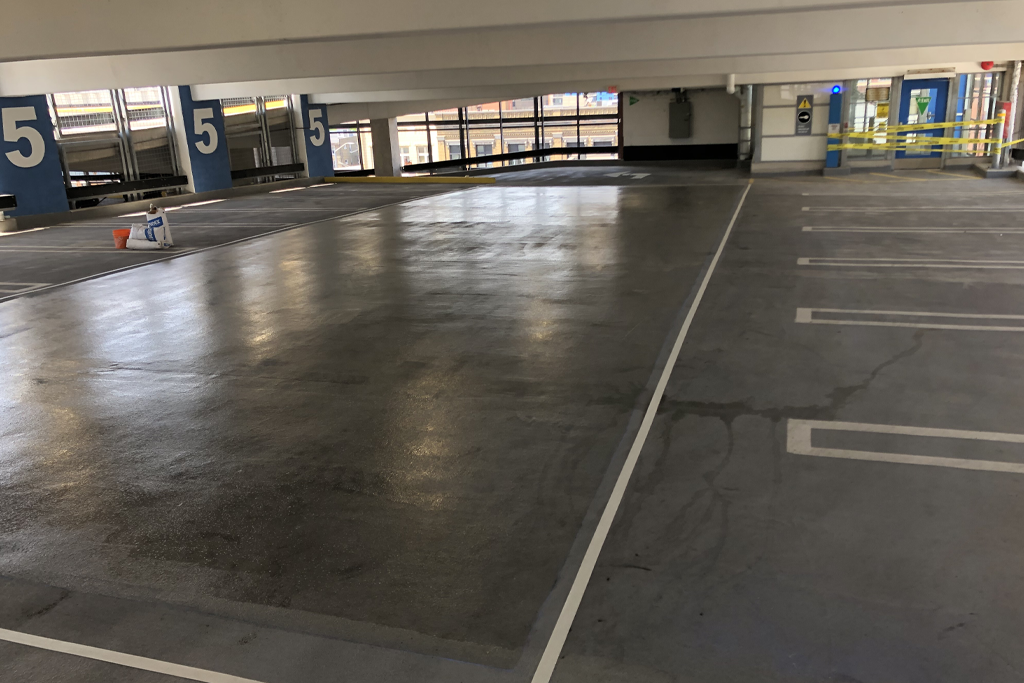Keeping Decay at Bay
5 best practices for maximizing the service life of your traffic deck coating
By Bryant Bortolotto-Freeman
If your building includes a parkade, chances are you’ve witnessed the wear and tear that comes from steady usage and exposure to moisture and contaminants like road salts. Even if the parking area is located indoors, the traffic deck coating (TDC) used to protect concrete surfaces will deteriorate over time, reducing its ability to effectively do its job.
“Traffic deck coating plays a key role in preserving concrete’s structural integrity, so it’s important to ensure it performs as intended,” said Bryant Bortolotto-Freeman, Engineer-in-Training at RJC Engineers. “By understanding the causes of concrete deterioration and following certain best practices to maximize your TDC, costly repairs to your concrete may be averted.”
What is Traffic Deck Coating?
A TDC is a multi-coat system formulated to protect concrete structures and structural elements from contact with moisture and contaminants. Typically, they are made up of a primer (polyurethane or epoxy-based), a basecoat, and a topcoat that work together to provide waterproofing protection, traction enhancements, wayfinding and light reflection in parkades and other concrete enclosures. Although usage of TDCs is widespread in North American, Bortolotto-Freeman has seen all-too often what happens when maintenance is ignored, or improper application creates weaknesses in the system. Common failures include debonding of the coating from the underlying substrate (or between the layers, cracks and scrapes letting in moisture, and surface damage from abrasion due to wheel racking and traffic exposure.
To prevent a failure and prolong the service life of your TDC, Bortolotto-Freeman recommends the following 5 Layers of Success:
Layer 1 – Surface Prep
Thorough surface preparation is crucial for a successful TDC installation, whether it’s brand- new concrete or an existing slab undergoing repairs. As such, shot blasting is an effective way to remove any micro-fractures, laitance, and provide the sound, open-textured surface area required for sufficient coating adhesion. For an existing system, shot blasting also removes the top surface of concrete, which can contain grease, rubber from tires, or other contaminants that could interfere with bonding and curing.
Layer 2 – Special Project Considerations
Service life conditions and project requirements should be considered during the design and material-selection phase. According to Bortolotto-Freeman, thicker wearing surfaces may be necessary for high-traffic areas, such as drive aisles and loading docks, possibly requiring a more robust wearing surface in lieu of typical aggregate. Turnaround times and curing temperatures should also be considered at this stage to prevent improper phasing of the work, which could negatively impact bond strength and durability. It’s also a good time to consider signage, barricades, and site presence, particularly if portions of the parking facility are to remain open.
Layer 3 – Monitoring and Testing
Verifying the product is being placed and applied in conformance with the manufacturer’s specifications is key to ensuring a long-lasting service life of your TDC. Given the coating forms a water barrier, Bortolotto-Freeman warns that any trapped moisture within the slab will create vapour drive with temperature fluctuations, potentially causing it to de-bond from the concrete substrate. Monitoring as you go, testing thickness and ensuing the product is being applied properly, will help minimize any negative outcomes down the road.
Layer 4 – Addressing “Tricky” Details
While placing a new coating in the centre of a concrete slab is relatively straightforward, perimeters during coating repairs are more susceptible to failures. These tricky areas require a little more attention to detail and may call for additional tools and techniques. For instance, rather than relying on a lap, Bortolotto-Freeman recommends using ground/saw cut reglets to provide mechanical adhesion along with a physical separation between the new coating and the existing one. He also recommends detailing at the cracks and upturns prior to large-scale TDC application to prevent moisture from gathering at the bases of columns, walls, and curbs, and migrating where it shouldn’t.
Layer 5 – Compatibility with Existing Surface
When repairing an existing coating, it’s important to know if the new product is polyurethane-based or bitumen-based to ensure compatibility with the existing TDC. While polyurethane alone is stable with bitumen, the plasticizers that make the TDC flexible and elastic are not. According to Bortolotto-Freeman, bitumen tends to attract the plasticizers within the TDC system, causing it to discolour and become brittle, and creating the potential for cracking. As the plasticizers interact with the bitumen-based product, the bitumen becomes soft and can bleed or run if in a vertical application. The best way to mitigate this is by a compatible intermediate layer like metal.
In conclusion
Proper specification, design, application, and assessment of traffic deck coatings is necessary to ensure these systems perform as intended, and they should also be maintained throughout their service life. Annual condition reviews by a consultant, as recommended by CSA S413, can help identify and address typical wear and use items prior to them causing costly concrete and/or structural repairs.
For more information: Visit www.RJC.ca or contact Bryant Bortolotto-Freeman directly at bbortolotto-freeman@rjc.ca




